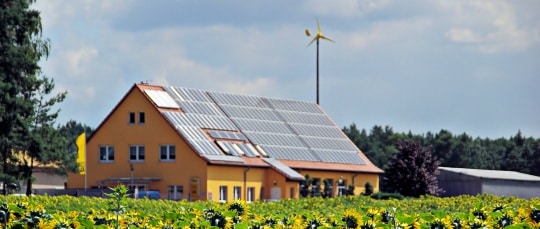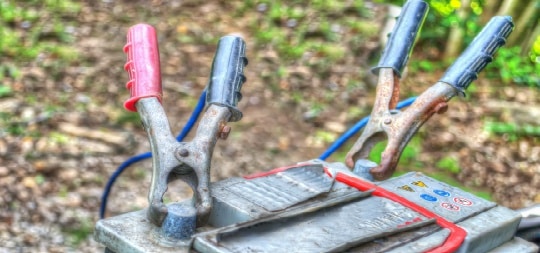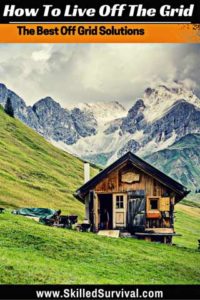
Because living entirely off the grid takes serious long-term planning. It also takes dedication and more importantly, know-how. And that’s why you’re here; to learn how to live off the grid.
Definition of Off-Grid Living
Before we deep dive into all these off grid topics, it’s worth a quick note about what we mean by living off grid. Because it can mean slightly different things to different people.
However, we can all agree that living off the grid means being off the electrical grid. But to me, that’s just one aspect of how to live off the grid.
I like the idea of getting off all grids and systems, not just the power grid. Working toward the ultimate goal of 100% self-reliant living. Self-reliance includes off grid heating, water supply, sanitation, and food.
↓ The TRUTH about OFF GRID LIVING that NO ONE WILL TELL YOU
By the time you finish reading this article, you will fully understand all your “off grid” options and the pros and cons of each.
Helping you take meaningful action to start planning your off grid escape.
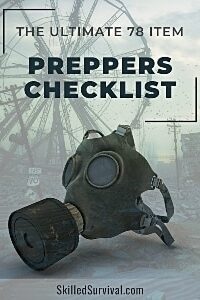
Want a free 78 item preppers checklist?
Enter your email below to instantly download this Complete Checklist PDF. No purchase necessary. 👇 👇Choosing An Off Grid Shelter
First up, let’s go over a few of the most popular off grid survival retreat options. You could go with a small home, a log cabin, an RV, or a yurt. There are also a few unique options you could consider such as a shipping container or an earthbag home.
Regardless of the option you choose, they all have one thing in common; small. Why? Because we’re focused on off grid and it’s easy and faster to get off the grid with waste efficiency-sided shelters.
Large sprawling mansions take an enormous amount of electricity to power and heat. That equates to more money and resources to get off the grid. So unless money is no object for you, you’ll want to keep your energy and heating requirements as low as possible.
Power generation is the real key to getting off the grid, so that’s what we’ll cover next.
Getting Off The Power Grid
Before you spend any time, energy, or money getting off the power grid, you should focus on using less first. The less energy you use, and the less you waste, the easier/faster you can make the off grid switch. Heck, if you start using zero power right now, you can be grid power independent immediately.
Seriously, think about early frontier homesteads before the invention of electricity.
They lived 100% off the grid because there was NO grid. But nowadays, we’re not forced to that extreme.
Due to modern technology, we take advantage of the power of electricity to help make our lives easier. And I’m not referring to easier like TV or video games. But for real beneficial technologies like refrigeration.
Living without refrigeration is a major hassle. Not one most people want to even think about. So the modern luxuries you should start cutting in preparation for off grid life are:
- TV
- Video games
- Evening lighting
- Computers
- Clothes dryers
- Hairdryers
- Microwaves
- Etc.
Again, you don’t need to remove all electrical luxuries. But the more you cut, the cheaper and quicker living off the grid will be.
You’ll also want to focus on acquiring energy-efficient appliances. The less energy these devices use, the smaller (and more affordable) you’re off-power grid system will become. So spend serious time putting together your energy usage game plan early in your off-grid planning.
To help facilitate this planning, I recommend getting a P3 P4400 Kill A Watt Electricity Usage Meter. This meter lets you track and measure your home’s energy usage device by device. Figuring out what uses the majority of your home’s energy helps prioritize your off-grid plan.
Plus, recording this data will be essential when it comes to sizing your off grid power system. Helping you plan the size and number of solar panels or the size of your wind turbine, etc.
The bottom line is: The lower your energy requirements, the easier it is to get off the grid.
Your Three Main Power Options
There are three fundamental ways to generate off grid power:
- Solar Panels
- Wind Turbines
- Micro Hydraulic Generators
Otherwise known as; Sun, Wind, and Water. Each of these systems focuses on natural energy sources that surround us daily. We just need the right tools and technology to harness and capture it for our off-grid needs.
1. Solar Panels
Solar panels are what most people think first when they hear the term off-grid. Buy a few panels, slap them on your roof, and voila, you’re off the grid. But not so fast; there’s more to it than that.
First, you need the sun and lots of it.
If you live in Alaska where winter months barely see the sun or Seattle where a permanent cloud often blocks the sun, then solar is not going to be in the cards for you. So assuming you do live in a region that has an abundance of sunny days per year, you’re also going to need to invest in a battery system.
However, solar power does not provide a consistent amount of power. At night when the sun goes down, you produce zero power and in the mornings and afternoons, they produce less than at the Sun’s apex.
So you’ll need a way to store the excess energy in a battery bank during peak energy production hours so you can use some of that stored energy when production is low (or at zero).
We’ll focus more specifically on your battery options shortly, but for now, just know it’s an essential component of your solar energy off grid plan.
Here’s the ultimate DIY off grid solar panel video guide, it’s a must-watch and will explain and answer just about any question you have in regards to off grid solar:
↓ The Ultimate Guide To DIY Off Grid Solar Power
Here’s a good solar panel starter kit you can invest in to start building your off grid solar system. If you’re looking for a “done for you” solar generator, check out The Patriot Power Generator 1500.
Let’s recap the pros and cons of using solar for your off grid living needs:
Solar Pros
- Method That’s Proven To Work
- No Moving Parts, So Relatively Low Maintenance
- Plenty of Sizing Options – Start Small and Expand Over Time
- Works Great In Abundant Sun Regions
Solar Cons
- It depends on a Sunny Region
- Requires Battery System
- Costs Can Be Expensive (especially if hired out)
- Takes Electrical Knowledge If DIY
2. Wind Turbines
Wind power is another proven natural energy source but has similar challenges to solar. The Wind comes and goes, so it’s not a consistent power source. Hence, again, you’ll need to pair it with a bank of batteries.
There are regional considerations and local considerations with the wind.
First of all, some regions of the USA get lots of wind regularly. And if your off grid home location is in one of these regions, then that’s a major plus. But you also need to consider your local surrounding land.
The fewer wind-blocking obstacles, such as hills and trees, the better. Otherwise, you’ll need to install the wind turbine relatively high off the ground (above these barriers) to get a clear wind profile. But higher installs add another level of complexity.
Wind turbines require occasional maintenance, so the higher you mount it, the more difficult it is to access for regular maintenance. It’s a significant tradeoff you’ll want to be aware of before you install one on your off grid property. And that’s the other thing with wind turbines; they are rotating mechanical devices that require regular maintenance and repair.
So there will be ongoing costs related to this, or if you plan to DIY the maintenance, you’ll need to educate yourself on your turbine. And there is more technology in these devices than you first suspect. So if you’re not technically inclined, wind turbines might not be your best option.
Wind Turbine Pros
- Plenty of Sizing Options
- Method That’s Proven To Work
- Works Well In Windy Locations
Wind Turbine Cons
- It depends On Windy Regions
- Needs Batty System
- Moving Parts Require Maintenance and Repair
Here’s a good wind turbine overview. This guy was able to install a wind turbine and connect it to his bank of deep-cycle batteries in a fairly straightforward setup.
↓ Wind Turbine Installed & Operating on the Homestead
Here’s the 24-volt, 1600-watt Missouri Freedom Wind Turbine. This company is known for its excellent customer support to keep your turbine operational.

Want a free 78 item prepper checklist?
Enter your email below to instantly download this Complete Checklist PDF. No purchase necessary. 👇 👇3. Micro Hydro Generator
And now we come to the water turbine, and it’s one of my favorite options (if available). The reason it’s my favorite is due to its continuous, reliable power-producing nature.
This option is fantastic if you have a strong flowing water source. For a water turbine to work, there are a few requirements:
You need a steady and reliable flow of natural water (think rivers, streams, large creeks, waterfalls, etc.) Stagnate water won’t work, and seasonal flows won’t work for continuous power, either.
If a drought can dry up the river every summer, you’ll lose your source of energy during those dry seasons. The reason is that the flowing water is your energy source. It’s the same idea as a water wheel. The ones created for manufacturing before the advent of electricity.
Instead of using mechanical energy (water wheels and gears) to create power, we can use a modern water turbine design. Water turbines are much smaller than water wheels and convert the water-flowing energy into electricity. Then you can use wires to transport that electrical power to your home.
As I said, the largest advantage of the water turbine is the constant flow of energy. Again, assuming the water flow is strong and reliable, you may be able to get away without energy storage (aka battery systems).
As we’ll discuss shortly, battery systems are great, but they are an added headache. They are amazing, but it’s always better not to need them at all when possible. But even if you still must employ a battery system, you’ll be able to wake up every morning to a fully loaded battery system.
With solar and the wind, you’ll start off most mornings in an energy deficit.
So what’s the downside? The biggest hurdle to using water turbines for your off grid home is finding a location with a flowing water source and then purchasing it.
Properties with water sources such as these are hard to find. And when you do find them, you typically have to pay an arm and a leg for them. Especially if you buy an already established off grid home.
If you can snag a remote off grid location, you’ll probably pay a little bit less. But then you have to build a house in a remote location and then build a road to access this home, etc.
You’re also out of luck in a situation of a severe drought. You must fully understand where the water source starts and how reliable it is. For example, what happens during a record-low winter snowfall if the water source comes from melting mountain snow?
Will your strong creek become a dry creek bed during the summer months? Not good. Here’s a good video giving you one way to set up a micro-hydro turbine:
↓ Micro Hydro Power with Turgo Generator Part 1
↓ Micro Hydro Power with Turgo Generator Part 2
Here’s a more advanced DIY option showing you how to make a vertical turbine hydro-generator with permanent magnets:
↓ Verticle turbine hydro generator system
And a final video of using a low-flow creek with a steep grade to generate your power from:
↓ Off-Grid #1 Oregon Micro Hdro energy alternatives
To recap:
Water Turbine Pros
- Constant Power – Batteries May Be Optional
- No Regional Limitations
Water Turbine Cons
- Hard To Find A Good Setup (rare)
- Land Costs
- Severe Droughts
- Moving Parts Require Maintenance and Repairs
So those are your 3 main off grid energy generation options. To complete this section, let’s briefly discuss battery systems.

Want a free 78 item prepper checklist?
Enter your email below to instantly download this Complete Checklist PDF. No purchase necessary. 👇 👇Image Source
Off-Grid Battery Systems
A Note About Battery Technology
Battery technology has come a long way in recent years, and I foresee it making more leaps and bounds in the coming years.
One of the latest iterations is the Tesla Power Wall. It’s the first step in making large, safe, and simple battery bank systems available to the masses. Sure, dedicated DIY’ers have been stringing deep-cycle batteries together for years.
And this is still the best option today for your money. But battery technology will advance sooner or later, allowing the masses to start getting off the power grid. And the sooner, the better because it’s a technology that helps increase our society’s self-reliance instead of reducing it.
The Deep Cycle Battery Bank
But for now, the traditionally connected bank of deep cycle batteries is tried and true and works just fine. This setup will effectively store your excess off grid energy production.
The biggest downside is the chemicals and safety issues related to storing these chemicals in or near your off grid home. Another downside is that these battery systems have a lifespan.
Chemical-based batteries only have so many loading and unloading cycles before they are no longer viable. That is unless you learn how to recharge them properly.
So it’s an occasional expense you’ll need to deal with, and if SHTF, battery replacement will become more challenging than swinging into a local Battery Plus store.
Here are a couple of videos giving you some more details related to your off grid living battery options. First up is information on selecting the right type and size batteries for your off grid systems:
↓ Choosing batteries for solar power off grid or a battery bank
And here’s a small DIY battery system to give you an idea of how to get started. Plus, it shares some “what not to do” tips:
↓ Off-Grid Solar Power System
Hybrid Off Grid Energy Systems
I recommend you invest in a couple of these off grid power systems.
- There’s no reason you can’t take advantage of both solar and wind.
- Or water and solar.
- Or all 3.
Backup, and redundant systems, make total sense. Especially if electricity downtime is highly detrimental to your specific off grid setup.
If you’re planning on running a refrigerator and freezer.

Want a free 78 item prepper checklist?
Enter your email below to instantly download this Complete Checklist PDF. No purchase necessary. 👇 👇Heating Your Off-Grid Home
Thus far, we’ve only focused on off grid electrical energy solutions but what about heat? Unless you live in a mild year-round climate (San Diego or Hawaii), then you’ll need to generate heat in the cooler months.
There are several options to heat your off grid home, but using traditional electric heaters is not a viable one.
At first glance, it would seem like using electricity would make the most sense, right? Since we just covered the topic of how to generate our own off grid electrical power, why not just use this electricity to warm your home? It takes a massive amount of electrical energy to convert enough of it into heat.
You’ll likely need way more electrical power than you’re willing to invest in these systems to heat your home this way.
For the lucky few, you might be able to get away with this setup if you have a fantastic water turbine configuration generating copious amounts of constant energy.
Paired with a small well-insulated home, it’s possible to make a setup like that work, but that’s exceedingly rare. So for this article, I will cover my three favorite non-electrical heating options and let you decide from there.
Again each option has its tradeoffs. The main options I will cover to produce heat are a firewood rocket stove, a geothermal system, and a compost heating system.
1. Rocket Stove
If firewood is abundant at your off-grid property, then you should take advantage of that. But chopping firewood for a traditional fireplace is a brutal never-ending chore.
You’ll need to chop down trees and split wood all summer long to prepare for the winter. And you’ll need to stay a season ahead of the game.
Green, freshly chopped wood doesn’t burn effectively or efficiently. It needs a season to dry out before it’s ready to heat your home. So you need to chop this year’s stockpile for next year’s winter.
For our forefathers, it was a continuous, grueling, but essential chore for their very survival.
For now, you can pay someone else to do the work. Find a local landscaper selling firewood and get several cords each year for winter. You’ll need to haul it and not worry about slipping and chopping. But in this situation, you’re relying on others which goes against our central premise of getting off the grid systems.
So you’ll want to know how to do this chore yourself. You can use a chainsaw as long as there’s fuel available to run it. But if you can no longer get fuel, then what?
Time to get your manual ax out and learn what callouses are all about. So that’s the tradeoff with firewood.
The more self-reliant you want to be, the more work it is. It’s not like electricity, where once you set it up, you only need to maintain it. With a firewood-based heat source, it will always be a constant job if you want to be 100% self-reliant.
But even with all that said, I still like firewood systems for generating heat for small off grid homes. Why? Because of the latest iteration of fireplace technology called rocket stoves.
Rocket stoves use firewood much more efficiently. You will get more BTUs out of each log than a traditional fireplace. This means you need less firewood for the winter.
Less wood means less work.
Here’s an excellent introduction to rocket stoves you should watch:
↓ Rocket Mass Heaters: A better-burning wood stove
2. Geothermal Heating Systems
One option that seems to be getting more attractive is geothermal. A geothermal heating unit uses about a third of the energy of an all-electric-based heating unit. And the trend is only getting better from an energy efficiency standpoint.
So why does a geothermal system use so much less energy? Because it’s not converting electricity directly into heat, the electrical is only pumping water and moving air via fans.
The basic concept is utilizing the earth’s constant temperature (vs. the air) to exchange heat.
This difference between the ground temperature and air temperature (in combination with using a refrigerant) turns the heat differential into heat for your off grid homes.
I won’t bore everyone with all the technical details, check out this article if you want.
But the bottom line: This system is a great option for your off grid abode. So geothermal is moving from the fringes to a real off grid option to consider:
↓ Benefits of Geothermal Heating and Cooling
3. Compost Water Heater
This option is powerful and works well with the right setups. What I love about this heat source is that you should compost on your off grid property anyhow. The idea behind using compost for heat is the energy released in the breakdown of organic materials.
When organic materials break down, they release large amounts of excess heat in the process. You can then capture some of this heat using water tubes and the principles of heat transfer.
The best example of this process in action is garden compost. When done right, you can see, feel, and smell this heat when someone “turns over” a full-functioning compost pile. Fantastic, so what’s the catch?
The catch is that you must continuously supply this setup with fresh organic material to break down. The good news is you can often find free bulk amounts of woodchips. And wood chips are a good organic compost material.
You can also use grass clippings, leaves, or anything else that naturally decays. And if you’re raising livestock, you can also add their manure to the compost heap.
Livestock continuously emits a waste stream called manure. This manure is an excellent organic compound for composting.
Here are several videos covering many more aspects and options for setting up a compost heat energy source.
↓ Agrilab Technologies Compost Heat Recovery Overview
↓ Combustion-Free Hot Water
↓ Compost-Powered Water Heater
Off Grid Water Systems Options
Just like power, focus first on using less and wasting less. Cut down on the frequency and length of your showers.
Wash your dishes by hand and only turn the water on sparingly.
Water management becomes even more critical if you start your off grid journey manually carrying water, but reduced water use is good practice for any off grid water system.
After you cut down on your water needs, the next key to off grid water systems is having a source of reliable water. If your proposed location doesn’t have this, you need to think long and hard before you purchase any off grid land without water.
During a disaster, relying on shipped water to your off grid home is a terrible idea. Instead, you should focus on having a river, lake, pond, spring, or stream nearby.
Another possible option is drilling a water well to tap into the water table.
So I will assume you have a water resource within a reasonable distance from your home, and I’ll go over some options for utilizing this natural resource.

Want a free 78 item prepper checklist?
Enter your email below to instantly download this Complete Checklist PDF. No purchase necessary. 👇 👇Carrying Water / Filling Storage Container Manually
It’s not ideal and not something you want to do long-term. But it will help you get off the grid quickly. Whether it’s a natural spring, creek, or pond. If worst comes to worst, you can always carry your water from this water source to your home.
As long as you have some WaterBricks. Just be forewarned manually carrying water will get really old, really fast.
If you’re still in the planning phase of your off grid home location, you may want to take the “distance from water source” into the off grid shelter build location.
↓ Off Grid Living Water Systems: Rain Water Harvesting
Ideal Home Water Setup
Before we go into more water source options, I first want to talk about the ideal setup of your water system. Ideally, you want both water storage and water pressure for your off grid system.
Why? Because water storage systems act similarly to the battery systems, we discussed earlier with electricity generation. Water storage allows you to use increasing or decreasing amounts of water “on your terms” and not on the water source’s terms.
So you want your water source to fill up your water storage tanks, and then you use water out of your storage tanks.
Ideally, you also want to be able to pipe your water system into your off grid home with pressure. Pressure makes it so water will flow out your taps. Water pressure is a major convenience worth spending time, energy, and money to setup up.
The good news is water storage is fairly easy.
Install a few large plastic containers between your water source and home. The way to get pressure is a bit harder but still doable. You’ll need to raise your storage tanks above your home and use gravity to build water pressure naturally.
The way to get pressure is a bit harder but still doable. You’ll need to raise your storage tanks above your home and use gravity to build water pressure naturally. So the best situation is to have your water source above your storage tanks so that they can fill up automatically using gravity.
And then, locate your water storage tanks above your home’s water taps, creating the water head pressure for your showers, kitchen, and bathrooms.
Note: If you’re not 100% confident in the purification of the water, then water storage tanks make large-scale purification possible.
Drilling A Water Well
This option works well for some property locations. You drill down underground and tap into the water table.
At the bottom of this well, you add a water pump and use your off grid power energy (or a solar-powered water pump) to pump this water up from the water table.
Just be aware that it can be expensive to drill a dry well. So the best way to avoid this fate is not to be the first Guinea Pig in your area. Check out the closest neighbors first. If they have successful water wells, you’re odds of also installing a successful well go up significantly.
In some areas with really high water tables, you may be able to get away with digging your water wall by hand using one of these. But for most water wells, you’ll need a large rig to do the job and drill down hundreds of feet.
Which is much more expensive but may be a great investment for the right property.
↓ All about wells ..Where to DRILL or locate your well
Using Gravity
If your water source (spring, pond, or creek) is physically higher than your home, then you can use gravity to flow the water to your home (and with pressure).
You’ll need to run a pipe system from the water source to your home water storage system.
If you have enough head pressure (difference in height between the water source and your home), then this will automatically fill your home’s water storage system.

Want a free 78 item prepper checklist?
Enter your email below to instantly download this Complete Checklist PDF. No purchase necessary. 👇 👇Different Gravity Setups
Storage Tanks Setup As Personal Water Tower
As we already briefly covered, you’ll want to locate your storage tanks above your point-of-use water tap locations. You should invest in a hydraulic ramp-up water system to fill your storage tanks locally without using any electrical power.
They are an ingenious solution to using a little bit of gravity head pressure to fill your water storage tanks using check valves.
↓ How To Build A Hydraulic Ram Pump
Once you are set up with a hydraulic ramp-up, it’s time to build your mini water tower storage system.
Here’s a two-video series showing a simple DIY water tank storage rack system for an off grid home. They use this setup for their
↓ How To Build A Water Tower Off-Grid Homestead
One note of caution, with an above-ground water tank storage system, you have to worry about freezing in colder climates. If freezing is possible, you may need to look at some underground storage options, like a buried cistern.
Buried Cistern
Another option is to bury your water storage tank on a hillside.
So instead of building up to store your tanks, you may be able to take advantage of your natural topography and get pressure by burying a cistern on a hillside. The primary benefit of doing this is to keep your water from freezing in the winter.
Freezing water can be a big hassle for above-water storage tanks in cooler climates.
Rainwater Harvesting
If you get constant rain year round, you should capture it via rainwater collection and harvesting. However, I have a hard time solely relying on this solution for your off grid water needs.
Droughts happen occasionally, and if that’s your only source of water, you’re screwed when a drought shows up. So rainwater harvesting is best used as a water subsidy rather than a primary water source.
That setup can work if you pair rainwater harvesting with manually carrying water. You may get away without carrying much water if you’re in a typical rainfall year. But you’ll still have carrying water as a solid backup plan.
OK, so here are two videos giving some details on how to set up an off grid rainwater harvesting system.
↓ Rainwater Harvesting Off Grid
↓ Rainwater Harvesting Off Grid 2

Want a free 78 item prepper checklist?
Enter your email below to instantly download this Complete Checklist PDF. No purchase necessary. 👇 👇Managing Waste Streams Off Grid
You have three main waste streams you must plan for.
- Human waste
- Gray water waste
- Trash waste
Human and Water Waste Streams
One solution for human and gray water waste is the tried and true septic tank.
A septic system is the best route for those who can 1) afford to have one installed, 2) can get the large equipment access to your location for installation, and pump out the solids every two years.
Here’s how septic systems work for those who are unfamiliar with their design:
↓ How a Septic System Works
Ok, so septic won’t work for every off grid home. So what are your other human waste and gray water options?
Human Waste – Compost
Turn your human wastes into compost by using a Composting Toilet.
↓ Best Composting Toilet System I’ve Seen Yet
Win, win. Turn your waste streams into compost. Use your compost to heat your water and your small home, then use the decayed compost to nurture and expand your garden. So you can support your off grid heating needs and food independence using your fundamental core waste stream. Awesome.
Gray Water Waste
The easiest way to deal with your gray water outside of a septic system is to pipe it away from your home so it can naturally absorb back into the ground. Some people even use their gray water to water their trees and gardens.
Just be cautious about any soaps or chemicals you use that end up in your gray water since those can be harmful to plants and trees in high concentrations.
Trash Waste Options
Non-Compostable Trash Waste
First off, reduce the amount of trash waste you generate. And for all waste streams that are organic in nature, add those to your compost heap. Duh! For remaining wastes, such as plastics, you have three options.
Option 1
Collect these items in a secured, sealed location to keep critters and animals from getting at them. Once you’ve filled up your waste storage location, you’ll take the trash to your nearest landfill for disposal.
Option 2
Bury it yourself. Make yourself a mini landfill on your property.
This setup works well if you 1) have enough land, so you’re not burying your trash close to your actual home, and 2) if you have a tractor with a front-end bucket. Otherwise, you’ll be digging this pit by hand.
Option 3
You can burn your trash in a burn barrel or burn pit. Growing up on a rural farm, with did a hybrid of options 2 and 3. We used a tractor to dig a burn pit; then, we added trash into the pit and occasionally lit it on fire.
Then once the ash and soot built up and filled the pit, we buried it and dug a new pit.
Off Grid Food Independence
Gardening, aquaponics, raising livestock, hunting, trapping, fishing, preserving meats, underground root cellar food storage, etc.
Details into each of these food topics are beyond the scope of this article; however, I’d be missing a huge part of off grid living if I didn’t mention it. Food independence is necessary for your off grid living, especially if your reasons for getting off the grid include self-reliance.
From a purely survival and preparedness aspect, food independence is as important as power independence. So you should spend some time researching each of these options and including them in your how-to-live-off-the-grid plans.
And if done right, you can create self-supporting systems.
- Turning waste streams into compost, using compost for large
garden plots. - Growing foods that feed your livestock.
- Using livestock for meats, cheeses, and milk.
- And then breeding your livestock to replace the ones you use for meat.
Working towards getting your independent food systems in place to reduce your dependence on the food grocery store system.

Prepare, Adapt & Overcome,
P.s. - I just found out 2 out of 3 Americans don’t feel prepared for a 3 day disaster!!!
I guess this goes to show how modern society continues to embrace ‘living a fragile life.’ What’s crazy is… it’s so easy to fix.
To make sure YOU have the basics, watch our FREE training on “10 Simple Steps To Basic Preparedness” that shows you HOW.
Nothing crazy here… this isn’t doomsday prepping... just the basics every responsible adult should have before a disaster strikes.Why You Can Trust Skilled Survival...
Go here now to review a full breakdown of:
- Who We Are
- Our Credentials
- Our Mission
- & Product Recommendations...
Here are a few highlights of our teams credentials & certifications:
- Certified Member of a Mountain Search & Rescue Organization
- Plant Emergency & Safety Leader for a Major Food Manufacturer
- Member of the 10TH Mountain Division Hut Association
- Certifications: Avalanche 1, WFR, CPR
- Official Gear Tester for Numerous Outdoor Gear Companies
- Countless Multiday Backpacking trips into Remote Wilderness
- Bachelor's Degree In Mechanical Engineering
- Bachelor's Degree In Civil Engineering
- Bachelor's Degree In Biomedical Engineering
"It takes 20 years to build a reputation and five minutes to ruin it." - Warren Buffett
We're fully aware that trust is NOT something you GET but is EARNED.
And we'll continue to earn YOUR trust through our forthright and honest approach with each new Blog Post, Guide & Product we create...
P.s - I just took this FREE 60-second 'Readiness Score Quiz'👇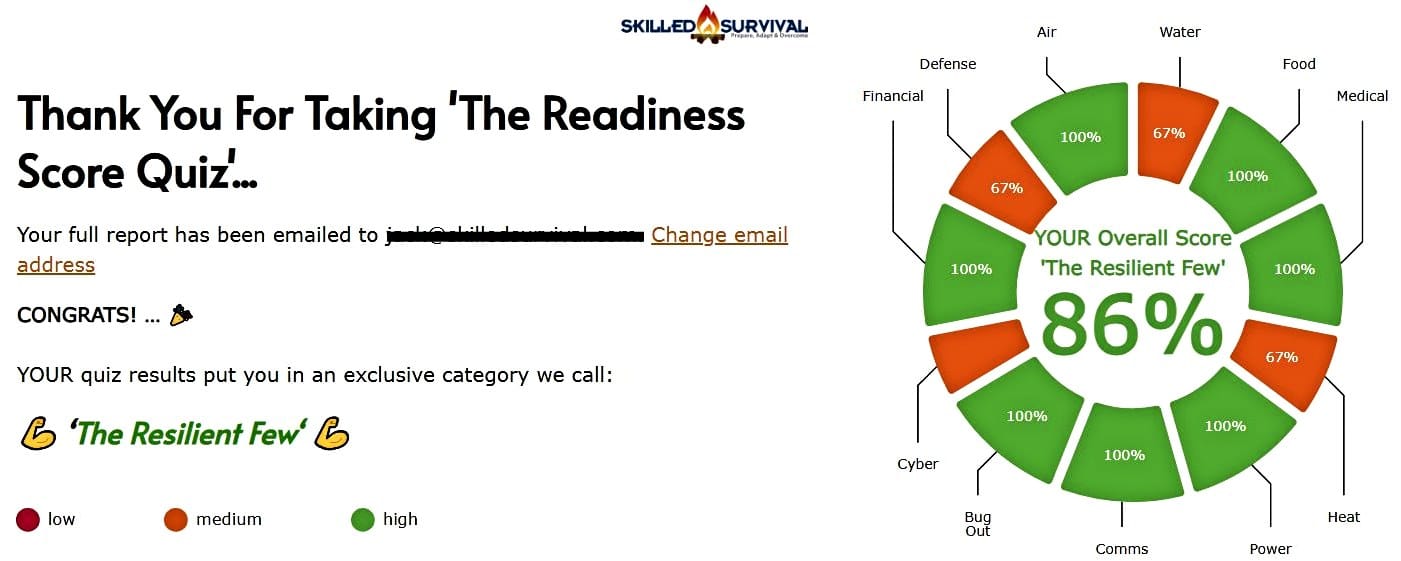
AND... I've still got a few gaps in my preps...🤔 But at least, I'm not part of 'The Fragile Masses'. 👍 Find out where YOU stand by answering a few questions...
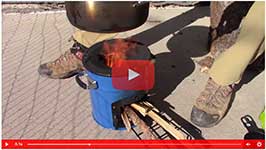
Recommended Reading
Long Term Fuel Storage For Survival Emergencies
Long term fuel storage is crucial in emergencies, but fuels must be stored properly especially long term gasoline storage.
How To Store Seeds For Wise Prepping & Survival
When seed saving and seed storage, you must do it right. Learn how to store seeds so they'll thrive the next planting season.
Common Everyday Carry Mistakes YOU Must Avoid At All Costs
The only person qualified to build YOUR Best Everyday Carry (EDC) is YOU. To do it right, you must avoid these common mistakes and pitfalls.
Strategic Relocation: How To Find A Safe Pace To Live
Use strategic relocation to find a safe, defendable location to call home. Your choice of location WILL determine your survival fate.
Nuclear Fallout Map: Would I Survive A Nuclear Bomb?
Have you seen this nuclear fallout map? Or run a nuclear simulation to see the damage a nuke would do to your city? If not, check this out.
Homestead Survival: How To Master Plan Your Safe Haven
Use this simple 6 homestead survival plan to successfully survive (and thrive) even if the world falls into chaos...
